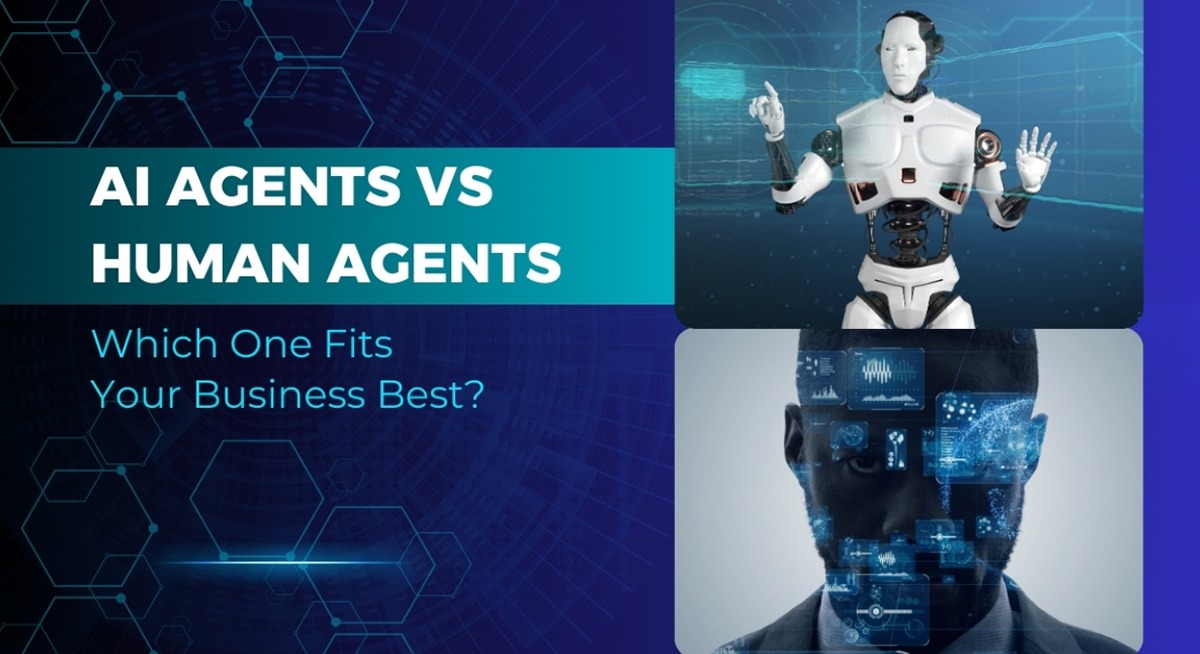
In today’s fast-changing business world, the debate of AI Agents vs Human Agents is heating up. Whether you run a startup, an e-commerce brand, or a large enterprise, one question often pops up: Should I rely more on AI-powered tools or continue investing in human customer support teams?
This isn’t just about cost-cutting—it’s about providing the best possible experience to your customers. Let’s break it down and help you decide what’s right for your business.
AI agents are software programs powered by artificial intelligence technologies such as machine learning (ML) and natural language processing (NLP). If you’d like a deeper dive into their role, check out this guide on What are AI Agents definition, examples, and types.
Think of chatbots, voice assistants like Siri or Alexa, or even advanced AI customer service platforms that can handle thousands of queries at once.
Businesses use AI agents to:
According to IBM, AI agents are becoming central to modern customer service, helping businesses scale without always adding headcount.
On the other hand, human agents are your customer service representatives, sales associates, consultants, and support staff. Unlike AI, humans bring a unique skill set: empathy, intuition, creativity, and emotional intelligence.
Examples of where human agents excel:
In industries like healthcare, finance, and hospitality, the human touch often makes all the difference.
Here’s a quick comparison to help you visualize the strengths of each:
| Feature | AI Agents ✅ | Human Agents ✅ |
| Speed & Availability | 24/7 instant responses | Limited to working hours |
| Cost-effectiveness | Lower long-term costs | Higher salary/training costs |
| Accuracy & Consistency | Very high (for simple tasks) | Can vary with fatigue or mood |
| Emotional Intelligence | Lacks empathy | Strong emotional connection |
| Scalability | Easy to scale | Limited scalability |
| Adaptability | Limited to programmed responses | Can think outside the box |
For example, e-commerce giants like Amazon use AI agents to recommend products, predict customer needs, and reduce support backlogs.
A NewVoiceMedia revealed that 75% of customers prefer interacting with a human agent for complex problems—proof that human connections still matter.
Instead of asking “AI agents vs human agents?”, a better question might be: Why not both?
Many forward-thinking companies are adopting a hybrid model, where AI agents handle routine inquiries while human agents focus on complex or sensitive interactions.
Examples of successful hybrid approaches:

This balance ensures efficiency without losing the human touch.
When deciding between AI and human agents, consider these factors:
Pro Tip: Start small. Deploy AI for repetitive tasks, monitor performance, and gradually expand while keeping human oversight.
Looking ahead, the future won’t be AI vs humans—it will be AI with humans. Advancements in Generative AI and Conversational AI will make machines sound more natural, but humans will remain essential for creativity, judgment, and empathy.
By 2030, analysts predict that AI will handle up to 80% of routine customer service interactions, while human agents will focus on high-value, relationship-driven tasks. Businesses that adopt this hybrid approach now will stay ahead of the curve.
The debate between AI agents and human agents isn’t about replacing one with the other — it’s about strategic collaboration. AI agents bring unmatched scalability, consistency, and 24/7 availability, while human agents provide empathy, creativity, and complex problem-solving.
The real business advantage comes from a hybrid, human-in-the-loop approach, where AI handles routine tasks and humans take on high-value interactions. This synergy creates a flexible, efficient, and customer-centric workforce.
👉 If you’re ready to take the next step and learn how to build and deploy AI agents effectively, the Gignaati AI Agents MasterClass is the perfect place to start. With hands-on guidance, real-world examples, and expert instruction, you’ll gain the skills to integrate AI into your business strategy with confidence.
Machine Learning (ML) is a branch of Artificial Intelligence (AI) that allows computers to learn from data and improve over time without being explicitly programmed. Instead of following fixed instructions, ML algorithms recognize patterns, make predictions, and get smarter with more data. Common examples include spam filters, Netflix recommendations, and voice assistants.
The four main types of Machine Learning are:
Semi-Supervised / Self-Supervised Learning – combines labeled and unlabeled data.
Each type suits different problems, from predicting prices to customer segmentation.
Machine Learning works in three steps:
Prediction – the model uses learned patterns to make decisions.
For example, spam filters learn from thousands of emails to correctly classify future messages.
Some widely used Machine Learning tools and frameworks include TensorFlow, PyTorch, Scikit-Learn, and Keras. These provide ready-to-use algorithms and deep learning capabilities. Cloud-based ML platforms such as Google Cloud AI, AWS Machine Learning, and Microsoft Azure ML also make it easier to scale projects for businesses and researchers.
Machine Learning is applied across industries:
Transportation: self-driving cars and traffic predictions
These applications show how ML enhances efficiency and personalization.
Machine Learning faces several challenges, including:
Scalability problems when handling big data
Businesses must pair ML innovation with ethical AI practices and strong infrastructure to overcome these challenges and ensure trustworthy outcomes.
Artificial Intelligence (AI) is the broader field of creating machines that mimic human intelligence. Machine Learning (ML) is a subset of AI focused on learning from data. In short, AI is the overall concept, while ML is the method that powers many AI applications. For example, AI covers speech recognition, and ML provides the learning mechanism.
The future of Machine Learning includes trends like AutoML, which makes ML accessible for non-experts, Explainable AI for transparency, Edge ML running on devices like smartphones, and Generative AI for creating text, images, and music. As these evolve, ML will become as essential to businesses as the internet is today.
Explore Gignaati.com – where top AI innovators showcase verified AI agents for real-world solutions.
© 2025 Gignaati is a product of Smartians.ai. All rights reserved.